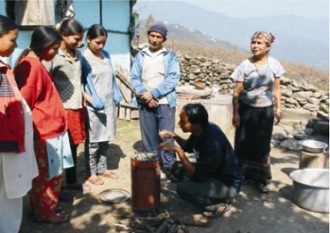CHULA
Intent: limit the dangerous health conditions caused by traditions of indoor cooking in many rural areas of the developing world. The Chulha is a stove designed to limit the dangerous health conditions caused by traditions of indoor cooking in many rural areas of the developing world.
The stove is being made available by Philips Design to the universe of social entrepreneurs so that they can, free of charge, produce the stove, themselves, and generate local business while helping counter what the World Health Organization estimates is some 1.6 million deaths per year from conditions prompted by the toxic fumes of indoor cooking with “bio-mass” fuels (wood, dung, peat, etc.).
The Chulha creates a safer environment for indoor cooking in several ways.
– It traps smoke and heat inside a locally cast housing in such a way as to heat two pot-holes with a high rate of efficiency to require less fuel;
– It then directs the smoke through a chimney chamber that includes a stack of slotted clay tablets – they capture particulates as the smoke moves through, cleaning the exhaust before it ever leaves the assembly; and
– The Chulha’s chimney then includes an indoor access for cleaning, eliminating the need seen in previous devices for a family member, usually the mother, to climb on the roof and attempt cleaning. This has been blamed for many accidents, along with the toxicity of the smoke.
Notably, Philips has gone to great lengths – and three iterations of the Chulha design – to make it something that seems familiar and attractive to users in the field. Conscious that tradition is the basis for much of the issue the Chulha addresses, Philips’ designers have concentrated much sensitivity on generating a readily
acceptable response to the problem.
“It all started back in 2005,” says designer Unmesh Kulkarni of the Philips Design Team based in Pune, India. “In observance of 80 years of design, Philips brought together about 250 designers to look at global issues. Our CEO, Stefano Marzano, wanted to look at our ability to think about solving social problems.”
INDEX:Award recipient Stefano Marzano, CEO and Chief Creative Director at Philips Design in Eindhoven, the Netherlands, says, “The target users of the Chulha are all the families in rural environments. The focus for the creation of the Chulha was India, however there are similarities in many countries in Africa, Latin America and other regions, as well as in India.”
“The fact that this product can be manufactured by even the end-user creates the opportunity in any location,” Marzano says, “to actually start the production of the product.”
How to spend 100.000 Euro on more design to improve life
Stefano Marzano, CEO and Chief Creative Director for Philips Design (who developed the Chulha) says that Philips Design will spend the award on further supporting the availability of the Chulha in India. He says that Philips Design also is spending some of the money to “further understand what would be the variations that we have to take to the design in order to also introduce this proposition in other countries where people do cook in a different way and the context in which they do this. ”Another part of the award will be going to develop the project “Healthcare 2050”, which is a part of the Icsid World Design Congress taking place in Singapore in November 2009.
Designed by: Philips Design.
Design team: Unmesh Kulkarni; Praveeen Mareguddi, India.
Additional credits: Bas Griffioen; Simona Rocchi, the Netherlands.
Partners: Appropriate Rural Technology Institute (ARTI); end-users.




{ 1 comment… read it below or add one }
The stove is an improved version as compared to the traditional two pot stoves in use and an improved design by me based on the Rocket stove principles by Larry Winiarsky about 4 years back. 300 families are using them since then.